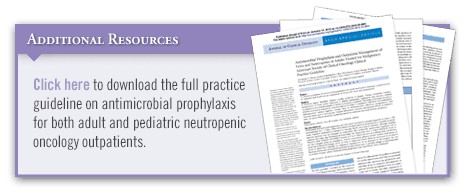Neutropenia, a common condition among cancer patients that is caused by low levels of neutrophils, can be caused by cancer itself or by the types of chemotherapy used. People with neutropenia are much more likely to develop infections when compared with those who have normal blood counts. Febrile neutropenia occurs when patients with neutropenia develop fevers, which are a sign of possible infection. Typically, febrile neutropenia is treated by immediately hospitalizing patients and providing them with intravenous antibiotics to prevent life-threatening complications, such as sepsis. Recent studies, however, suggest that select patients who are at low risk of complications related to febrile neutropenia may be eligible for outpatient treatment.
The American Society of Clinical Oncology (ASCO) has issued a clinical practice guideline update on the management of neutropenia with fever and for the prevention of related infections in cancer patients. ASCO also endorsed a related guideline for children with cancer. To develop these guidelines, an expert panel systematically reviewed evidence from relevant medical literature, including 47 seminal articles.
“These guidelines are intended to help physicians identify patients at high risk of medical complications related to neutropenia with fever,” says Christopher R. Flowers, MD, MS, who co-chaired the ASCO expert panel that drafted the guideline for adults. “They also provide clarity on when preventive treatment for infection is needed.” Additionally, guidance is offered on managing select patients who can be managed safely at home during febrile neutropenia episodes.
Hospitalizations & Assessing Risks
According to Dr. Flowers, a priority of ASCO’s guidelines was to help clinicians identify patients with febrile neutropenia who do not require hospitalization. “The guideline will help spare select patients from the discomfort and risks of being hospitalized, such as exposure to treatment-resistant microbes,” he says. “It also has the potential to save substantial resources.”
“To successfully manage these complications, it’s critical that patients
and their caregivers be educated on how to promptly recognize and act on
signs and symptoms.”
An important component to ASCO’s guideline is a description of how well-validated scoring systems can be applied to assess the risk of complications from febrile neutropenia (Table). “Patients who don’t have a fever and have very low absolute neutrophil counts—less than 100 per microliter for more than 7 days—can also be managed safely at home with oral antibiotics and antifungals to prevent infection,” adds Dr. Flowers. “We can improve outcomes by identifying those who can be safely managed at home.”
Recommendations for other aspects of care are provided in ASCO’s guidelines, including the prevention of infection for patients with neutropenia but no fever and the initial treatment for febrile neutropenia. In addition, antibacterial recommendations are provided for the initial empiric therapy for outpatients with febrile neutropenia who are at low risk for medical complications.
Pediatric Febrile Neutropenia
The pediatric guideline endorsed by ASCO provides recommendations on diagnosis, ongoing management, and initial antifungal and antibacterial treatment of febrile neutropenia in children with cancer and those undergoing blood stem-cell transplantation. The guidelines incorporated evidence from pediatric clinical trials and adapted evidence from adults for use in children. This comprehensive, evidence-based guideline is intended to specifically address the management of febrile neutropenia, a common complication in children with cancer who receive chemotherapy.
Opportunities Remain
Dr. Flowers recommends that clinicians review these documents to improve their ability to deliver high-quality care for patients with fever and neutropenia. “To successfully manage these complications, it’s critical that patients and their caregivers be educated on how to promptly recognize and act on signs and symptoms,” he says. “Effective communication about monitoring body temperature and other infection symptoms is critical. In many cases, patients are reluctant to seek help outside of office hours. As such, it’s paramount that we provide patients and caregivers clear written instructions on when and how to contact their providers to decrease the burden of these complications.”
ASCO’s guidelines also note that more opportunities exist to improve the quality of care for cancer patients experiencing fever and neutropenia. “More research is needed to develop and validate risk scoring systems to make them more sensitive and specific,” says Dr. Flowers. “Better data are also needed to define how long the observation period should be in hospitals or clinics before discharging patients to continue empiric therapy for febrile neutropenia episodes at home. Until this information emerges, clinicians should be confident in the data provided in ASCO’s guidelines and use the recommendations whenever possible to help in their care of these patients.”



